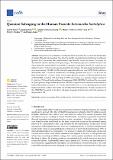Queuine Salvaging in the Human Parasite Entamoeba histolytica
Author(s)
Sarid, Lotem; Sun, Jingjing; Chittrakanwong, Jurairat; Trebicz-Geffen, Meirav; Ye, Jun; Dedon, Peter C.; Ankri, Serge; ... Show more Show less
Downloadcells-11-02509.pdf (3.487Mb)
Publisher with Creative Commons License
Publisher with Creative Commons License
Creative Commons Attribution
Terms of use
Metadata
Show full item recordAbstract
Queuosine (Q) is a naturally occurring modified nucleoside that occurs in the first position of transfer RNA anticodons such as Asp, Asn, His, and Tyr. As eukaryotes lack pathways to synthesize queuine, the Q nucleobase, they must obtain it from their diet or gut microbiota. Previously, we described the effects of queuine on the physiology of the eukaryotic parasite <i>Entamoeba histolytica</i> and characterized the enzyme EhTGT responsible for queuine incorporation into tRNA. At present, it is unknown how <i>E. histolytica</i> salvages queuine from gut bacteria. We used liquid chromatography–mass spectrometry (LC–MS) and N-acryloyl-3-aminophenylboronic acid (APB) PAGE analysis to demonstrate that <i>E. histolytica</i> trophozoites can salvage queuine from Q or <i>E. coli</i> K12 but not from the modified <i>E. coli</i> QueC strain, which cannot produce queuine. We then examined the role of EhDUF2419, a protein with homology to DNA glycosylase, as a queuine salvage enzyme in <i>E. histolytica</i>. We found that glutathione S-transferase (GST)-EhDUF2419 catalyzed the conversion of Q into queuine. Trophozoites silenced for EhDUF2419 expression are impaired in their ability to form Q-tRNA from Q or from <i>E. coli</i>. We also observed that Q or <i>E. coli</i> K12 partially protects control trophozoites from oxidative stress (OS), but not siEhDUF2419 trophozoites. Overall, our data reveal that EhDUF2419 is central for the direct salvaging of queuine from bacteria and for the resistance of the parasite to OS.
Date issued
2022-08-12Department
Massachusetts Institute of Technology. Department of Biological EngineeringPublisher
Multidisciplinary Digital Publishing Institute
Citation
Cells 11 (16): 2509 (2022)
Version: Final published version